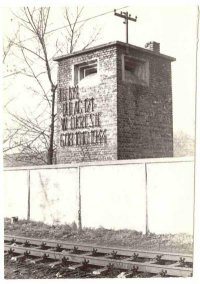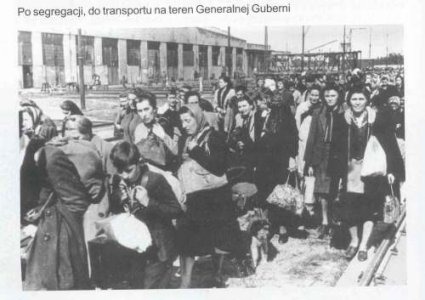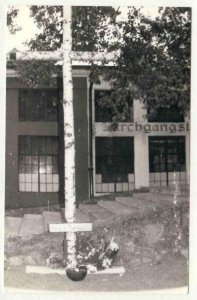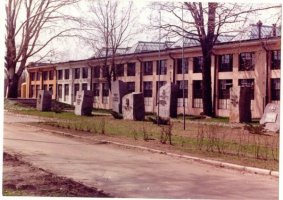
If one travels by rail from Warsaw to Skierniewice, between
suburban stations Piastów and Pruszków, one can notice a long almost 2-kilometer-long concrete wall, with heavy metal gate
embodied in it. Just behind the wall one can notice an old brick shooting-tower with words written underneath Warsaw went
through here from 6th August to 10th November 1944. Durchgangslager 121 Pruszków. Before the war broke out in 1939 the
place housed the Railway Repair Plant for over 100 years. After seizing Poland, Germans also repaired their trains in here.
After the outbreak of the Warsaw Uprising in 1944 Nazis designated
this place to become a transitional camp for civilians from Warsaw and surrounding towns, such as: Anin, Wawer, Zielonka,
Kobyłka, Tłuszcz, Łomianki, Boenerowo, Włochy, Jelonki. The localization was not accidental. A close distance to Warsaw
and access to a good railway network allowed Germans to smoothly organize the consequent groups of prisoners according to
a place of their destination.

This area was firstly used as a transitional camp back in 1939.
Thanks to the recollections of one of the few witnesses it was established that at the end of September 1939 Germans
kept officers of Polish Army in here, treating them as hostages during the siege of Warsaw.
The memoirs, including the inhuman treatment of those soldiers,
were written down by one of the then prisoners, dr Andrzej Fersten. The majority of the prisoners of the camp was
later executed.
In 1944 Durchgangslager 121 Pruszków operated between 6th August
and 10th November. Groups of people were sent here from the quarters of Warsaw that were being seized by the occupant.
The prisoners were kept in exceptionally primitive conditions, deprived of any help or care.

The camp had typically transitional character; the prisoners
were kept in it for about 2-3 days. The transports were coming and going. After the inhuman segregation and often breaking
of the families, prisoners were sent either to concentration camps or as slave labour to III Reich. Several percent of people
considered unable to work (mainly the mentally-handicapped, the ones suffering from tuberculosis, wounded civilians, pregnant
women, mother with children under 15, women over 50 and the elderly) were sent from the camp into the towns of General
Governship. Those taken to perform slave labour were taken either to transitional camp in Breslau (Wrocław) and then to
southern Germany or to transitional camp near Berlin and then to northern Germany. The insurgents, the youth and Polish
intellectuals were taken to concentration camps in Auschwitz, Mathausen and Stutthof.
Thanks to smart actions of the members of Polish Red Cross
working in the camp several people were illegally rescued from the camp. A few hundreds of people were released by the
authorities of the camp and for the period of convalescence taken to nearby hospitals.
The area of the camp was surrounded with 2-metre-high concrete
wall. The camp housed nine production halls, destined for the prisoners. Each hall was additionally surrounded with a fence
made of barbed wire and was patrolled by Germans. Special attention was given to halls 7 and 8 where Warsaw insurgents
were kept. These were those who surrendered while possessing weapons, those with white-and-red armbands on and those
being in vicinity of the fights.

The halls housed between 2 and 6 thousand people. They were not
prepared to house so many people, especially so frequently rotating. People slept on concrete floors, considering themselves
very happy if they found an odd piece of carton or a wooden board. Mud and dirt covered the floors. The conditions were so
terrible that a lot of people (despite the coldness at night) preferred to camp outside, by the halls fences.
Looking at the testimonies of the witnesses one can say that
individual executions took place in the camp, especially of those who attempted escape. Mass executions also occurred. After
the war the exhumation took place nearby the camp and 50 shot bodies were discovered, of which only 3 could be identified. A
lot of prisoners died of exhaustion, diseases, hunger or wounds. In the first period the statistics of the dead were not run.
German authorities that were responsible for full feeding of
the expelled population, gave bread and coffee only once a day. Through the workers of the Polish Red Cross the inhabitants
of Pruszków and nearby towns as well as villages provided the help.
Around 650 thousand (750 thousand according to some sources) people went through that camp. The intensification of
transports depended on the outcome of fights in the capital.
The calendar of transports to Durchgangslager 121 Pruszków, in accordance to gradual seizure of Warsaw::

| 6th - 8th August | Wola |
| 6th - 8th August | Powiśle |
| 9th - 14th August | Ochota |
| 19th August - 13th September | Praga |
| 22nd August | Sielce, Dolny Mokotów |
| 24th August | Krakowskie Przedmieście |
| 31st August - 5th September | Stare Miasto (Old Town) |
| 2nd - 3rd September | Sadyba |
| 5th - 9th September | Powiśle |
| 12th - 17th September | Bielany, Marymont |
| 25th - 28th September | Mokotów |
| 28th September - 1st October | Żoliborz |
| 2nd - 10th October | Śródmieście |

350 thousand people considered unable to work were sent to various
towns within General Governship. 150 thousand were sent to III Reich, 50 thousand into concentration camps and 100 thousand
legally or illegally released from Pruszków camp.
After the Rising 1944, Warsaw became a dead and defendless city,
deprived of its inhabitants and defenders. Due to crazy idea
of Adolph Hitler (who doomed the proud city to be erased from the Earth) special troops of Verbrennungkomando destroyed the
town for three following months. With German precision and with the help of explosive materials quarter after quarter and
house after house they destroyed the town that before the war was often called Paris of the East. Everything that had
possessed some value was robbed, everything else was destroyed. Warsaw practically ceased to exist. From 3rd October 1944
to January 1945 set explosive materials to or burnt around 30% of pre-war buildings. They destroyed 5% more buildings than
they did during 2 months of fights. In 1945 Soviet and Polish troops entered the ruins of the town, left behind by the fleeing
German garrison.
In the beginning of 1947 the commemorative plaque was unveiled
opposite the entrance to the hall no 5. It was however as late as in the 1970s (and from the initiative of the Plant
authorities) that the decision about erecting a monument was taken. The design was prepared by professor Oskar Hansen
and the production was supervised by the Plant worker, Jan Eljaszewicz, who as a child was a prisoner at the camp. It was
also him who designed and sculpted the words and ornaments. The unveiling and blessing of the monument took place on 24th
April 1990, on the centenary of the company.

The monument has the form of wide composition made of 11 symbolic
elements, creating one plastic entity. Particular parts of the monument symbolise the tragedy of particular Warsaw districts,
the victims of Durchgangslager and those who attempted to help them. The words on the hall Warsaw went through here from 6th
August to 10th October 1944. Durchgangslager 121 Pruszków are vivid testimony of tragedy that took place here. One of the
elements of the monument commemorates the defenders of Warsaw from September 1939.
On 9th October 2004 we witnessed special event take place in
former Durchgangslager - commemoration 60th anniversary of the camp establishment. The same day was the day when the branch
of Warsaw Uprising Museum was opened in Pruszków.


